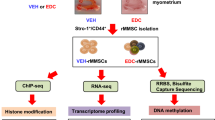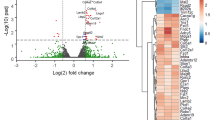Abstract
Environmental exposures during development can alter susceptibility later in life to adult diseases including uterine leiomyoma, a phenomenon termed developmental reprogramming. The goal of this study was to identify genes developmentally reprogrammed by diethylstilbestrol (DES) and aberrantly expressed in leiomyomas. Transcriptional profiling identified 171 genes differentially expressed in leiomyomas relative to normal myometrium, of which 6/18 genes with putative estrogen responsive elements and confirmed to be estrogen-responsive in neonatal uteri were reprogrammed by neonatal DES exposure. Calbindin D9k and Dio2, normally induced by estrogen, exhibited elevated expression in DES-exposed animals during both phases of the estrus cycle. Gdf10, Car8, Gria2, and Mmp3, genes normally repressed by estrogen, exhibited elevated expression in DES-exposed animals during the proliferative phase, when estrogen is highest. These data demonstrate that neonatal DES exposure causes reprogramming of estrogen-responsive genes expressed in uterine leiomyomas, leading to over-expression of these genes in the myometrium of exposed animals prior to the onset of tumorigenesis.
Similar content being viewed by others
References
Gluckman PD, Hanson MA Developmental plasticity and human disease: research directions. J Intern Med. 2007;261: 461–471.
Smith-Gill SJ Developmental plasticity: developmental conversion versus phenotypic modulation. Am Zool. 1983;1:47–55.
Bateson P., Barker D., Clutton-Brock T., et al. Developmental plasticity and human health. Nature. 2004;430:419–421.
Birnbaum LS, Fenton SE Cancer and developmental exposure to endocrine disruptors. Environ Health Perspect. 2003;111:389–394.
Kyung-Chul C., Eui-Bae J., Leung PCK. Impact of environmental endocrine disruption on the reproductive system for human health. Immunol, Endocr & Metab Agents-Med Chem. 2006;6:3–13.
McLachlan JA, Newbold RR, Shah HC, Hogan MD, Dixon RL Reduced fertility in female mice exposed transplacentally to diethylstilbestrol (DES). Fertil Steril. 1982;38:364–371.
Miller KP, Borgeest C., Greenfeld C., Tomic D., Flaws JA In utero effects of chemicals on reproductive tissues in females. Toxicol Appl Pharmacol. 2004;198:111–131.
Newbold RR, Banks EP, Bullock B., Jefferson WN Uterine adenocarcinoma in mice treated neonatally with genistein. Cancer Res. 2001;61:4325–4328.
Palmer JR, Wise LA, Hatch EE, et al. Prenatal diethylstilbestrol exposure and risk of breast cancer. Cancer Epidemiol Biomarkers Prev. 2006;15:1509–1514.
Herbst AL, Scully RE Adenocarcinoma of the vagina in adolescence. A report of 7 cases including 6 clear-cell carcinomas (so-called mesonephromas). Cancer. 1970;25:745–757.
Herbst AL, Cole P., Colton T., Robboy SJ, Scully RE Age-incidence and risk of diethylstilbestrol-related clear cell adenocarcinoma of the vagina and cervix. Am J Obstet Gynecol. 1977;128:43–50.
Herbst AL, Ulfelder H., Poskanzer DC Adenocarcinoma of the vagina. Association of maternal stilbestrol therapy with tumor appearance in young women. N Engl J Med. 1971;284:878–881.
Kaufman RH Structural changes of the genital tract associated with in utero exposure to diethylstilbestrol. Obstet Gynecol Annu. 1982;11:187–202.
Goldberg JM, Falcone T. Effect of diethylstilbestrol on reproductive function. Fertil Steril. 1999;72:1–7.
Hatch EE, Troisi R., Wise LA, et al. Age at natural menopause in women exposed to diethylstilbestrol in utero. Am J Epidemiol. 2006;164:682–688.
Baird DD, Newbold R. Prenatal diethylstilbestrol (DES) exposure is associated with uterine leiomyoma development. Reprod Toxicol. 2005;20:81.
Troisi R., Titus-Ernstoff L., Hyer M., et al. Preeclampsia risk in women exposed in utero to diethylstilbestrol. Obstet Gynecol. 2007;110:113–120.
Walker CL, Stewart EA Uterine fibroids: the elephant in the room. Science. 2005;308:1589–1592.
Cook JD, Davis BJ, Cai SL, Barrett JC, Conti CJ, Walker CL Interaction between genetic susceptibility and early-life environmental exposure determines tumor-suppressor-gene penetrance. Proc Natl Acad Sci U S A. 2005;102:8644–8649.
Cook JD, Davis BJ, Goewey JA, Berry TD, Walker CL Identification of a sensitive period for developmental programming that increases risk for uterine leiomyoma in eker rats. Reprod Sci. 2007;14:121–136.
Newbold RR, Moore AB, Dixon D. Characterization of uterine leiomyomas in CD-1 mice following developmental exposure to diethylstilbestrol (DES). Toxicol Pathol. 2002; 30:611–616.
Zheng X., Hendry WJ, 3rdNeonatal diethylstilbestrol treatment alters the estrogen-regulated expression of both cell proliferation and apoptosis-related proto-oncogenes (c-jun, c-fos, c-myc, bax, bcl-2, and bcl-x) in the hamster uterus. Cell Growth Differ. 1997;8:425–434.
Nelson KG, Sakai Y., Eitzman B., Steed T., McLachlan J. Exposure to diethylstilbestrol during a critical developmental period of the mouse reproductive tract leads to persistent induction of two estrogen-regulated genes. Cell Growth Differ. 1994;5:595–606.
Mo R., Tony Zhu Y., Zhang Z., Rao SM, Zhu YJ GAS6 is an estrogen-inducible gene in mammary epithelial cells. Biochem Biophys Res Commun. 2007;353:189–194.
Suzuki A., Watanabe H., Mizutani T., Sato T., Ohta Y., Iguchi T. Global gene expression in mouse vagina exposed to diethylstilbestrol at different ages. Exp Biol Med (Maywood). 2006;231:632–640.
den Hollander P., Rayala SK, Coverley D., Kumar R. Ciz1, a Novel DNA-binding coactivator of the estrogen receptor alpha, confers hypersensitivity to estrogen action. Cancer Res. 2006;66:11021–11029.
Thomassin H., Flavin M., Espinas ML, Grange T. Glucocorticoid-induced DNA demethylation and gene memory during development. Embo J. 2001;20:1974–1983.
Li S., Washburn KA, Moore R., et al. Developmental exposure to diethylstilbestrol elicits demethylation of estrogen-responsive lactoferrin gene in mouse uterus. Cancer Res. 1997;57:4356–4359.
Ho SM, Tang WY, Belmonte de Frausto J., Prins GS Developmental exposure to estradiol and bisphenol A increases susceptibility to prostate carcinogenesis and epigenetically regulates phosphodiesterase type 4 variant 4. Cancer Res. 2006;66:5624–5632.
Taniuchi K., Nishimori I., Takeuchi T., Fujikawa-Adachi K., Ohtsuki Y., Onishi S. Developmental expression of carbonic anhydrase-related proteins VIII, X, and XI in the human brain. Neuroscience. 2002;112:93–99.
Supuran CT, Scozzafava A. Carbonic anhydrases as targets for medicinal chemistry. Bioorg Med Chem. 2007;15:4336–4350.
Nishikata M., Nishimori I., Taniuchi K., et al. Carbonic anhydrase-related protein VIII promotes colon cancer cell growth. Mol Carcinog. 2007;46:208–214.
Tsibris JCM, Segars J., Enkemann S., et al. New and old regulators of uterine leiomyoma growth from screening with DNA arrays. Fertil Steril. 2003;80:279.
Kelly BA, Bond BC, Poston L. Gestational profile of matrix metalloproteinases in rat uterine artery. Mol Hum Reprod. 2003;9:351–358.
Lemaitre V., D’Armiento J. Matrix metalloproteinases in development and disease. Birth Defects Res C Embryo Today. 2006;78:1–10.
Croteau W., Davey JC, Galton VA, St Germain DL Cloning of the mammalian type II iodothyronine deiodinase. A selenoprotein differentially expressed and regulated in human and rat brain and other tissues. J Clin Invest. 1996;98:405–417.
Wasco EC, Martinez E., Grant KS, St Germain EA, St Germain DL, Galton VA Determinants of iodothyronine deiodinase activities in rodent uterus. Endocrinology. 2003;144:4253–4261.
Wasco EC, Martinez E., Grant KS, St. Germain EA, St. Germain DL, Galton VA Determinants of iodothyronine deiodinase activities in rodent uterus. Endocrinology. 2003;144:4253–4261.
Ambroziak M., Pachucki J., Stachlewska-Nasfeter E., Nauman J., Nauman A. Disturbed expression of type 1 and type 2 iodothyronine deiodinase as well as titf1/nkx2-1 and pax-8 transcription factor genes in papillary thyroid cancer. Thyroid. 2005;15:1137–1146.
Kim BW, Daniels GH, Harrison BJ, et al. Overexpression of Type 2 iodothyronine deiodinase in follicular carcinoma as a cause of low circulating free thyroxine levels. J Clin Endocrinol Metab. 2003;88:594–598.
Curcio C., Baqui MM, Salvatore D., et al. The human type 2 iodothyronine deiodinase is a selenoprotein highly expressed in a mesothelioma cell line. J. Biol. Chem. C100325200.
Song S., Oka T. Regulation of type II deiodinase expression by EGF and glucocorticoid in HC11 mouse mammary epithelium. Am J Physiol Endocrinol Metab. 2003;284:E1119–1124.
Cunningham NS, Jenkins NA, Gilbert DJ, Copeland NG, Reddi AH, Lee SJ Growth/differentiation factor-10: a new member of the transforming growth factor-beta superfamily related to bone morphogenetic protein-3. Growth Factors. 1995;12:99–109.
Hino J., Kangawa K., Matsuo H., Nohno T., Nishimatsu S. Bone morphogenetic protein-3 family members and their biological functions. Front Biosci. 2004;9:1520–1529.
Katoh Y., Katoh M. Comparative integromics on BMP/GDF family. Int J Mol Med. 2006;17:951–955.
Yu J., Zhu T., Wang Z., et al. A Novel set of DNA methylation markers in urine sediments for sensitive/specific detection of bladder cancer. Clin Cancer Res. 2007;13:7296–7304.
Kraunz KS, Nelson HH, Liu M., Wiencke JK, Kelsey KT Interaction between the bone morphogenetic proteins and Ras/MAP-kinase signalling pathways in lung cancer. Br J Cancer. 2005;93:949–952.
Dou Q., Zhao Y., Tarnuzzer RW, et al. Suppression of transforming growth factor-beta (TGF beta) and TGF beta receptor messenger ribonucleic acid and protein expression in leiomyomata in women receiving gonadotropin-releasing hormone agonist therapy. J Clin Endocrinol Metab. 1996;81:3222–3230.
Bruns ME, Overpeck JG, Smith GC, Hirsch GN, Mills SE, Bruns DE Vitamin D-dependent calcium binding protein in rat uterus: differential effects of estrogen, tamoxifen, progesterone, and pregnancy on accumulation and cellular localization. Endocrinology. 1988;122:2371–2378.
Christakos S., Gabrielides C., Rhoten WB Vitamin D-dependent calcium binding proteins: chemistry, distribution, functional considerations, and molecular biology. Endocr Rev. 1989;10:3–26.
Hong EJ, Choi KC, Jeung EB Induction of calbindin-D9k messenger RNA and protein by maternal exposure to alkylphenols during late pregnancy in maternal and neonatal uteri of rats. Biol Reprod. 2004;71:669–675.
Lee GS, Choi KC, Kim HJ, Jeung EB Effect of genistein as a selective estrogen receptor beta agonist on the expression of calbindin-D9k in the uterus of immature rats. Toxicol Sci. 2004;82:451–457.
An BS, Kang SK, Shin JH, Jeung EB Stimulation of calbindin-D(9k) mRNA expression in the rat uterus by octylphenol, nonylphenol and bisphenol. Mol Cell Endocrinol. 2002;191:177–186.
Krisinger J., Dann JL, Currie WD, Jeung EB, Leung PC Calbindin-D9k mRNA is tightly regulated during the estrous cycle in the rat uterus. Mol Cell Endocrinol. 1992;86:119–123.
Author information
Authors and Affiliations
Corresponding author
Rights and permissions
About this article
Cite this article
Greathouse, K.L., Cook, J.D., Lin, K. et al. Identification of Uterine Leiomyoma Genes Developmentally Reprogrammed by Neonatal Exposure to Diethylstilbestrol. Reprod. Sci. 15, 765–778 (2008). https://doi.org/10.1177/1933719108322440
Published:
Issue Date:
DOI: https://doi.org/10.1177/1933719108322440




